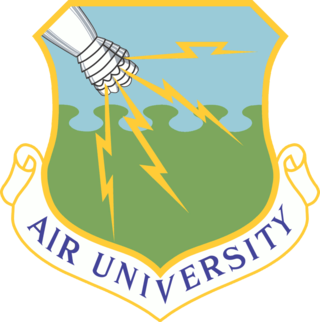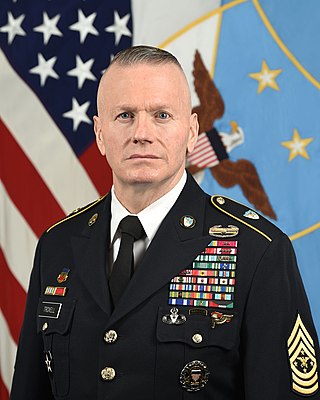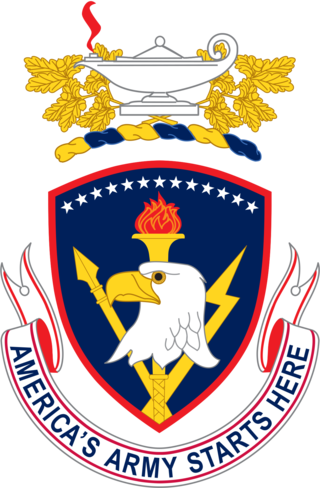
A non-commissioned officer (NCO) is a military officer who does not hold a commission. Non-commissioned officers usually earn their position of authority by promotion through the enlisted ranks. In contrast, commissioned officers usually enter directly from a military academy, officer training corps (OTC) or reserve officer training corps (ROTC), or officer candidate school (OCS) or officer training school (OTS), after receiving a post-secondary degree.

A chief master sergeant is the military rank for a senior non-commissioned officer in the armed forces of some countries.
A Noncommissioned Officer Professional Development Ribbon is an award presented by the United States Army, Air Force, and Space Force to recognize those noncommissioned officers (NCOs) who have completed a prescribed leadership course at an NCO training school. The Navy, Marine Corps, and Coast Guard have no equivalent to the Noncommissioned Officer Development Ribbon.

Kenneth O. Preston is a retired United States Army soldier who served as the Sergeant Major of the Army. He was sworn in as the 13th Sergeant Major of the Army on January 15, 2004. Preston served 7 years and 2 months as Sergeant Major of the Army making him the longest serving Sergeant Major of the Army to date.

Marine Corps University is a military education university system of the United States Marine Corps. It is part of the Naval University System and accredited by the Commission on Colleges of the Southern Association of Colleges and Schools to award Master's Degrees.

Air University is a professional military education university system of the United States Air Force. It is accredited by the Commission on Colleges of the Southern Association of Colleges and Schools to award master's degrees.

Jack L. Tilley is an American businessman and retired United States Army soldier. He served for almost 37 years in the United States Army, culminating in his appointment in 2000 as the 12th Sergeant Major of the Army, a post he held until his retirement on January 15, 2004. He was the last Vietnam War veteran to serve in that position.

William Joseph Gainey is a retired United States Army soldier who served as the first Senior Enlisted Advisor to the Chairman of the Joint Chiefs of Staff.

The senior enlisted advisor to the chairman of the Joint Chiefs of Staff (SEAC) is the most senior non-commissioned officer (NCO) position overall in the United States Armed Forces. The SEAC is appointed by the chairman of the Joint Chiefs of Staff to serve as a spokesperson to address the issues of enlisted personnel to the highest positions in the Department of Defense. As such, the SEAC is the primary enlisted advisor to the chairman, and serves at the pleasure of the secretary of defense. The SEAC's exact duties vary, depending on the chairman, though the SEAC generally devotes much of their time traveling throughout the Department of Defense, to observe training and communicating to service members and their families. The SEAC's normal term of assignment runs concurrently with the chairman, but an incumbent may be reappointed to serve longer. The first member to hold this post was William Gainey. The current SEAC is Troy E. Black, USMC who assumed the duties on 3 November 2023.
First sergeant is typically a senior non-commissioned officer rank, used in many countries.

All branches of the United States Armed Forces use the general term Enlisted Professional Military Education (EPME) to describe the formal system of education which each branch provides to its enlisted personnel. Each branch has its own system and sequence of courses, with the overall focus on leadership and management. Education generally increases in intensity and level of knowledge as individuals progress in rank and assume broader leadership roles. EPME is distinct from the technical training which service members receive for their Military Occupational Specialty (MOS), Air Force Specialty Code (AFSC), or Navy Rating.

Raymond F. Chandler III is a former United States Army soldier who served as the 14th Sergeant Major of the Army. He was sworn in on March 1, 2011, and active on duty until January 30, 2015. Chandler served in all tank crewman positions and has had multiple tours as a troop, squadron and regimental master gunner. He has served in the 1st Infantry Division (FWD), 2nd Infantry Division, 4th Infantry Division, 1st Cavalry Division, 3rd Armored Division, 2nd Armored Cavalry Regiment, 3rd Armored Cavalry Regiment, United States Army Armor School, and the United States Army Sergeants Major Academy. He also served as first sergeant in four different detachments, troops and companies. As a sergeant major, he served as Operations SGM in 1/2 ACR and as CSM in 1/7 Cavalry, 1st Cavalry Division, United States Army Garrison Fort Leavenworth, Kansas and the United States Army Armor School CSM. Chandler was assigned as the United States Army Sergeants Major Academy CSM in December 2007. In June 2009, Chandler became the 19th Commandant of USASMA and the first enlisted commandant in USASMA history.

Daniel A. Dailey is a former United States Army soldier who served as the 15th Sergeant Major of the Army from January 30, 2015, to August 9, 2019. Prior to his tenure as the Sergeant Major of the Army, he served as the Command Sergeant Major for the United States Army Training and Doctrine Command.

John Wayne Troxell is a retired United States Army senior non-commissioned officer who served as the third Senior Enlisted Advisor to the Chairman of the Joint Chiefs of Staff (SEAC). This position made him the most senior enlisted member of the United States Armed Forces. He enlisted in the United States Army in September 1982, as an armored reconnaissance specialist and graduated from One Station Unit Training at Fort Knox, Kentucky.

The United States Army Acquisition Corps (AAC) is the officer / NCO corps of the United States Army Acquisition Workforce (AAW), a branch which includes civilians, officers, and NCOs. The Acquisition Corps is composed of army officers who serve in acquisition, a specialized form of product development, fielding, and support and Noncommissioned Officers who specialize in Contracting, Level I Program Management and Purchasing. These officers begin their careers in the other branches of the army for eight years, after which they may elect the Acquisition branch as their career as assistant program managers (APMs), program managers (PMs), and program executive officers (PEOs). The Noncommissioned Officers (NCOs) are reclassified in the Army Acquisition NCO Corps after serving 7-10 years in their respective enlisted career management fields, and serve primarily in the Army Acquisition Career Management Field - 51 and (MOS) 51C. 4% percentage of the Army Acquisition Officers serve among the 40,000 members of the army acquisition workforce, 6% in MOS 51C - Acquisition, Logistics and Technology Contracting Noncommissioned Officer, and the remainder 90% percentage consist largely of Department of the Army civilians.

Michael Anthony Grinston is a retired soldier of the United States Army who served as the 16th Sergeant Major of the Army from 2019 to 2023. Prior to his term as Sergeant Major of the Army, he served as the senior enlisted leader for United States Army Forces Command.

John F. Bentivegna is a United States Space Force chief master sergeant who serves as the second and current chief master sergeant of the United States Space Force. He previously served as the senior enlisted advisor to the deputy chief of space operations for operations, cyber, and nuclear and senior enlisted leader of Space Operations Command.

The United States Army Recruiting and Retention College (RRC), located at Fort Knox, Kentucky, serves as the United States Army training brigade responsible for providing U.S. Army officers and non-commissioned officers (NCOs) with the knowledge, skills, and techniques to conduct recruiting and career counselor duties for the United States Army and Army Reserve at the company, battalion, brigade, and headquarters levels.

Michael R. Weimer is a United States Army soldier who has served as Sergeant Major of the Army since August 4, 2023. He previously served as the command sergeant major at the United States Army Special Operations Command.



















